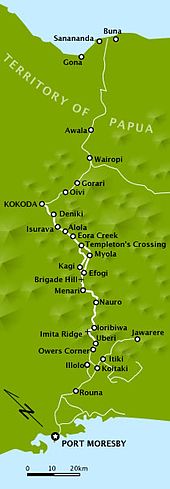Templeton's Crossing

Templeton's Crossing is a locality on the Kokoda Track in New Guinea. The original track, at the start of the Kokoda Track campaign, proceeded north from Kagi and crossed over the watershed of the Owen Stanley Range as it passed through "the Gap"[Note 1] – skirting the eastern side of Mount Bellamy. The track then proceeded north through the steep-sided Eora Creek valley. Templeton's Crossing is where the original track first crosses Eora Creek.[5][6][Note 2] It was named by (then) Lieutenant Bert Kienzle in memory of Captain Sam Templeton.[11] Templeton commanded B Company, 39th Battalion. It was the first of the battalion's companies to deploy overland for the defence of Kokoda – arriving shortly before the Japanese landings. Templeton was killed in the early stages of the Japanese advance. Kienzle was an officer of the Australian New Guinea Administrative Unit, that had been tasked, among other things, to establish supply dumps and staging points along the track. In the course of this, he was to guide Templeton's B Company over the track as it deployed.[12][13]
When the drop zone at Myola was identified by Kienzle, the main route used by the Australian forces was diverted through this important supply point, cutting a new section of track.[14][15] Kienzle named the "crossing" after cutting the route from Myola, north.[9] The route north from Myola first follows the Myola Ridge, before descending to cross Eora Creek at a point about an equal march between Myola and Templeton's Crossing. A supply dump, Dump 1, was established there. Rather than following the creek from there, the track crosses a ridge as it heads toward Templeton's Crossing. Confusingly, the site of Dump 1 has, in some sources, been identified as "Templeton's Crossing No 1" while the original crossing is called "Templeton's Crossing No 2". This appears to have originated from "Longitudinal section of the Kokoda Trail" produced in 1978 by the "Department of Works and Supply".[16]

Templeton's Crossing is associated with two battles of the Kokoda Track campaign of the Second World War fought between Australians of Maroubra Force and Japanese troops. Both battles consisted of a series of engagements that occurred in the upper reaches of the Eora Creek valley. The first battle was fought from 31 August 1942 to 5 September 1942, as the Australian forces were withdrawing in the face of the Japanese advance. The second battle was fought from 11 to 28 October 1942, as the Australian forces pursued the Japanese forces withdrawing back to the north coast of Papua. In each battle, a significant engagement was fought in the vicinity of Templeton's Crossing.[17][18]
References[edit]
- Notes
- ^ "The (Kokoda) Gap" is a dip in the Owen Stanley Range about 11 kilometres (7 mi) wide, convenient for aircraft crossing the range to pass through.[1] Such was the ignorance of the terrain by Allied planners, that it was perceived to be a narrow defile that could easily be blocked by explosives or held against a determined enemy by only a small force.[2][3][4]
- ^ Anderson[7] reports that it was named for a crossing of tracks and not for a crossing over Eora Creek. Maps provided by both Anderson[8] and McCarthy[6] show the new track section from Myola joining the old track but not a crossing of tracks. The maps also show the old track crossing Eora Creek at this point. James reports that Kienzle named the "crossing" after cutting the route from Myola, north.[9] To avoid confusion in his work, Anderson has chosen to refer to the bypassed section of track as the "Mount Bellamy Trail".[10] It is marked as such on his map.
- Citations
- ^ Kienzle 2011, p. 110.
- ^ Fitzsimons 2004, pp. 154–155.
- ^ McCarthy 1959, p. 141.
- ^ Brune 2004, p. 89.
- ^ "Battle of Templeton's Crossing". Australian War Memorial. Retrieved 5 September 2011.
- ^ a b McCarthy 1959, p. 216.
- ^ Anderson 2014, p. 76.
- ^ Anderson 2014, p. 73.
- ^ a b James 2009, p. 32.
- ^ Anderson 2014, p. 10.
- ^ Brune 2004, p. 113; Kienzle 2011, pp. 141–142; James 2009, p. 32.
- ^ James 2009, pp. 8–9 & 17.
- ^ Anderson 2014, pp. 25–31.
- ^ Anderson 2014, pp. 10 & 53.
- ^ McCarthy 1959, pp. 130–131.
- ^ James 2009, pp. 33 & 47.
- ^ Maitland 1999, p. 142.
- ^ Anderson 2014, pp. 72–87 & 132–192.
- Bibliography
- Anderson, Nicholas (2014). To Kokoda. Australian Army Campaigns Series – 14. Sydney, New South Wales: Big Sky Publishing. ISBN 978-1-922132-95-6.
- Brune, Peter (2004). A Bastard of a Place. Crows Nest, New South Wales: Allen & Unwin. ISBN 1-74114-403-5.
- Fitzsimons, Peter (2004). Kokoda. Sydney, New South Wales: Hachette. ISBN 978-0-7336-1962-5.
- James, Karl (2009). ""The Track": A Historical Desktop Study of the Kokoda Track" (PDF). Commonwealth Department of the Environment. Retrieved 29 November 2014.
- Kienzle, Robyn (2011). The Architect of Kokoda. Sydney, New South Wales: Hachette. ISBN 978-0-7336-2763-7.
- Maitland, Gordon (1999). The Second World War and its Australian Army Battle Honours. East Roseville, New South Wales: Kangaroo Press. ISBN 0-86417-975-8.
- McCarthy, Dudley (1959). South-West Pacific Area – First Year. Australia in the War of 1939–1945. Series 1 – Army. Vol. 5. Canberra, Australian Capital Territory: Australian War Memorial. OCLC 3134247.
